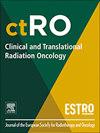ACO/ARO/AIO-22 -外束放疗联合直肠内高剂量率近距离治疗老年和体弱直肠癌患者:德国直肠癌研究组的一项前瞻性多中心试验
IF 2.7
3区 医学
Q3 ONCOLOGY
引用次数: 0
摘要
直肠癌对老年人的影响尤为严重,超过一半的病例在70岁或以上的人群中被诊断出来。由于手术并发症和围手术期发病率的增加,这组虚弱的患者经常面临耐受全肠系膜切除(TME)标准治疗的重大挑战。放射治疗技术的进步提供了一个可行的替代方案,提供有效的肿瘤控制,同时最大限度地减少治疗相关的毒性。最近的临床试验,包括OPERA和MORPEUS,已经证明了剂量升级放疗,将外射束(化疗)放疗(EBRT)与高剂量率的直肠内近距离放疗(HDR-BT)或接触x射线近距离放疗(CXB)相结合,可以在更年轻、更健康的患者群体中获得较高的临床缓解率,并促进器官保存。在这些发现的基础上,ACO/ARO/AIO-22研究试图采用这些创新方法来满足老年和体弱直肠癌患者的需求。方法/设计ACO/ARO/AIO-22试验为前瞻性多中心对照试验。老年人(年龄≥70岁)和/或体弱的非转移性直肠腺癌(cT1-3d N0/+ M0, mrCRM - /+)定位于距皮下线0-16 cm,无法进行根治性手术的患者可以包括在内。初始治疗包括13 × 3 Gy(总剂量:39 Gy)的外束辐射(EBRT)方案,持续两周半。在EBRT完成6.5周后进行首次重新安置,直肠内HDR-BT将以3周的8gy的剂量递送,总剂量为24gy(在肿瘤的径向边缘规定;最大处方深度为10mm);或者,每3周使用90 Gy的CXB。主要目标是完全或接近完全临床缓解(cCR或ncCR),第二个主要终点是在治疗开始后12个月用EORTC QLQ-ELD14测量的生活质量(QoL)。ACO/ARO/AIO-22前瞻性多中心试验将评估EBRT联合直肠内HDR-BT治疗老年和/或体弱直肠癌患者后的器官保存率和生活质量。试验注册:Clinicialtrials.gov号码:NCT06729645。本文章由计算机程序翻译,如有差异,请以英文原文为准。
ACO/ARO/AIO-22 – External beam radiotherapy combined with endorectal high-dose-rate brachytherapy in elderly and frail patients with rectal cancer: A prospective multicentre trial of the German Rectal Cancer Study Group
Purpose
Rectal cancer disproportionately affects the elderly population, with more than half of cases diagnosed in individuals aged 70 years or older. Frail patients in this group often face significant challenges tolerating the standard treatment of total mesorectal excision (TME), due to elevated risks of surgical complications and perioperative morbidity. Advances in radiotherapy techniques offer a viable alternative, providing effective tumor control while minimizing treatment-related toxicity. Recent clinical trials, including OPERA and MORPEUS, have demonstrated that dose-escalated radiotherapy, which integrates external beam (chemo)radiotherapy (EBRT) with high-dose-rate endorectal brachytherapy (HDR-BT) or contact X-ray brachytherapy (CXB), can achieve high clinical response rates and facilitate organ preservation in younger, healthier patient cohorts. Building on these findings, the ACO/ARO/AIO-22 study seeks to adapt these innovative approaches to meet the needs of elderly and frail patients with rectal cancer.
Methods/Design
The ACO/ARO/AIO-22 trial is a prospective multicentre controlled trial. Elderly (age ≥70 years) and/or frail patients with non-metastatic rectal adenocarcinoma (cT1-3d N0/+ M0, mrCRM − / +) localized 0–16 cm from the ano-cutaneous line, unable to undergo radical surgery can be included. The initial treatment comprises an external beam radiation (EBRT) regime with 13 × 3 Gy (total: 39 Gy) over a period of two and a half weeks. Following initial restaging 6.5 weeks after completion of EBRT, endorectal HDR-BT will be delivered with 3 weekly fractions of 8 Gy to a total dose of 24 Gy (prescribed at the radial margin of the tumor; with a maximum prescription depth of 10 mm); alternatively, with CXB with 90 Gy in 3 weekly fractions. The primary objective is complete or near complete clinical response (cCR or ncCR) and the second primary endpoint is quality of life (QoL) measured with the EORTC QLQ-ELD14, both at 12 months after treatment start.
Discussion
The ACO/ARO/AIO-22 prospective multicentre trial will evaluate organ preservation rates and QoL after combining EBRT with endorectal HDR-BT in elderly and/or frail patients with rectal cancer.
Trial Registration: Clinicialtrials.gov number: NCT06729645.
求助全文
通过发布文献求助,成功后即可免费获取论文全文。
去求助
来源期刊

Clinical and Translational Radiation Oncology
Medicine-Radiology, Nuclear Medicine and Imaging
CiteScore
5.30
自引率
3.20%
发文量
114
审稿时长
40 days
 求助内容:
求助内容: 应助结果提醒方式:
应助结果提醒方式:


